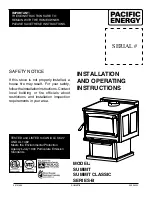
ENGLISH
Pellets and feeding
Pellets are made by subjecting wood shavings i.e. the rejects of pure wood (without paint) sawmill, carpenter products and products from
other activities connected to working and transforming wood, to very high pressures.
This type of fuel is fully ecological as no glues are used to hold it together. In fact, the compactness of the pellets is guaranteed over time by a
natural substance that is found in wood: wood coal.
As well as being an ecological fuel, as wood residues are made the most of, the pellet also has technical advantages.
While the wood has a calorific value of 4.4 kWh/kg. (with 15% humidity, then after about 18 months of seasoning), that of the pellet is 5 kWh/kg.
Pellet density is about 650 kg/m
3
and water content is equal to 8% of its weight. For this reason the pellets do not need to be seasoned in order
to obtain a sufficiently adequate heat yield.
tHe Use Of POOR QUalitY Pellets OR anY OtHeR MateRial daMages tHe fUnCtiOns Of tHe geneRatOR
and Can VOid tHe WaRRantY and tHe anneXed ResPOnsiBilitY Of tHe ManUfaCtUReR.
The pellet used must comply with the features described by Standards:
en PlUs - Uni en 14961 - 2 (Uni en isO 17225-2) class a1
- a2
The Manufacturer recommends using pellets with a diameter of 6mm
with its products.
Pellet stORage
To guarantee combustion without problems, the pellets must be kept
in a dry place.
Open the tank lid and load the pellets using a scoop.
Pellet tank - PRessURe ClOsURe.
During the operation of the stove, the pellet tank cover must always remain closed.
Keep it clean
BE SURE TO KEEP THE TANK LID GASKET SURFACE CLEAN AT ALL TIMES. FREQUENTLY CHECK THE CONDITION OF THE
GASKET. IF IT IS FOUND TO BE DETERIORATED, CONTACT YOUR LOCAL SPECIALISED TECHNICIAN.
15
















































